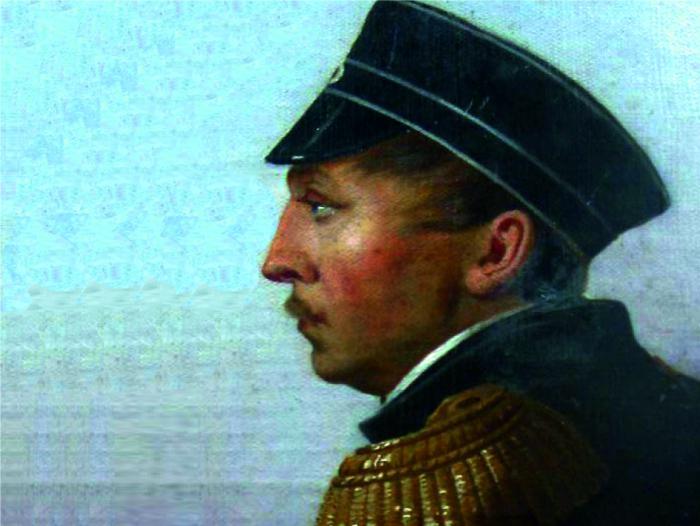In the spring of the penultimate year of the Great Patriotic War, military awards appeared that marked the contribution to the battle against fascism of sailors of all ranks and ranks: from ordinary Red Navy men to admirals.
Ushakov’s medal and Nakhimov’s medal were intended to award elders, sailors and midshipmen. Officers and admirals were awarded orders of the same name of two degrees.
Junior Maritime Award
The decree on the establishment of the USSR sea awards was issued on March 2, 1944, but the question of special - naval awards was raised earlier. The initiative in this belonged to the famous Soviet admiral, the drug navy of the USSR Navy Nikolai Gerasimovich Kuznetsov. He reported to Stalin on the advisability of establishing orders and medals dedicated to the memory of the great Russian naval commanders, back in mid-1943, and it became possible to realize the idea as early as next spring.
Navy operations to combat the enemy fleet at sea, the participation of coastal artillery batteries in the defense of coastal cities, the heroism of the marines in land battles - all this was highly appreciated by the high Soviet command, aroused hatred of the Soviet sailors among the Nazis and created them fame among the people. Stalin knew about the great contribution of sailors to the struggle against the fascist invasion, so he supported the idea of special naval awards. The Nakhimov Medal became the youngest among the four established award badges, but was especially appreciated not only by sailors and foremen, but also by officers.
Statute
According to the regulations, the basis for awarding the Nakhimov Medal was skillful and proactive actions for the successful completion of tasks by ships and formations of the Navy, and naval units of border troops in a combat situation. The Nakhimov Medal was considered an analogue of the Combat Merit medal and was held in such respect.
Awarding the Nakhimov Medal to those who served in other branches of the army did not contradict the provision. She could be presented to civilians. The soldiers and sergeants from the infantry, artillery and other ground troops, awarded the Nakhimov Medal, especially appreciated the interaction in battle with ships and marines. They considered her an introduction to the legendary sea fraternity.
Admiral N.G. Kuznetsov said that naval officers awarded combat medals were proud of them no less than more significant status orders. Given the bravery and courage in the fighting, the Nakhimov medal was a reliable testimony to the personal courage of a person wearing any military rank.
Pavel Stepanovich Nakhimov
Established in 1944, naval awards - the medal and order of Nakhimov - are named after one of the most legendary Russian naval commanders. Pavel Stepanovich Nakhimov was born into a poor noble family in 1802. Having decided to devote his life to military service at sea, he entered the Naval Cadet Corps. After his graduation, he traveled around the world, distinguished himself in a naval battle with the Turks in Navarino Bay, and commanded the legendary ships - frigates "Pallas" and "Navarin".

By the beginning of the Crimean War, in 1853, Nakhimov was vice admiral, commanded a large squadron as part of the Black Sea Fleet, had great authority over the command, was respected by lower ranks, and had great combat experience. All this allowed him to win his most important victory - under Sinope. This was the last battle of military vessels under sail, in which the Russian squadron led by Nakhimov, thanks to bold and skillful actions on November 18, 1853, completely destroyed the main forces of the Turkish fleet.
After the Sevastopol’s blocking by the Anglo-French forces and the death of Admiral V.A. Kornilov, Nakhimov was at the head of the troops defending the city until June 28, 1855, when he was mortally wounded on the Malakhov Hill.
Description of the medal
For the conceptual development of new awards, Admiral Kuznetsov attracted a whole group of sailors under the direction of the caperan B. M. Khomich. It was attended by N. A. Volkov, A. L. Diodorov and architect M. A. Shepilevsky. According to their design, the order and the Ushakov medal, the order and the Nakhimov medal were created. Photos of these insignia show them with the highest examples of medal art.
The only reward of the Great Patriotic War, made of bronze, is the Nakhimov medal - a disk with a diameter of 36 mm, through a soldered ear with a ring connected to a block fitted with a moire ribbon. Its coloring contains the motive of the sea collar - guis - three white stripes on a blue background.
On the obverse is the profile of P. S. Nakhimov, on both sides of which along the upper edge are convex letters: “Admiral Nakhimov”, below are laurel branches separated by a five-pointed star, the frame along the edges are convex points. The reverse side of the coin is an expressive composition from the image of a sailboat, framed in a circle by a cable superimposed on two anchors connected by a chain, convex points in a circle.
History
During the war years, about 13 thousand decorations were awarded with this distinction. The Nakhimov Medal was part of the current state awards until 2010 and left a noticeable mark in the glorious history of the Russian fleet.